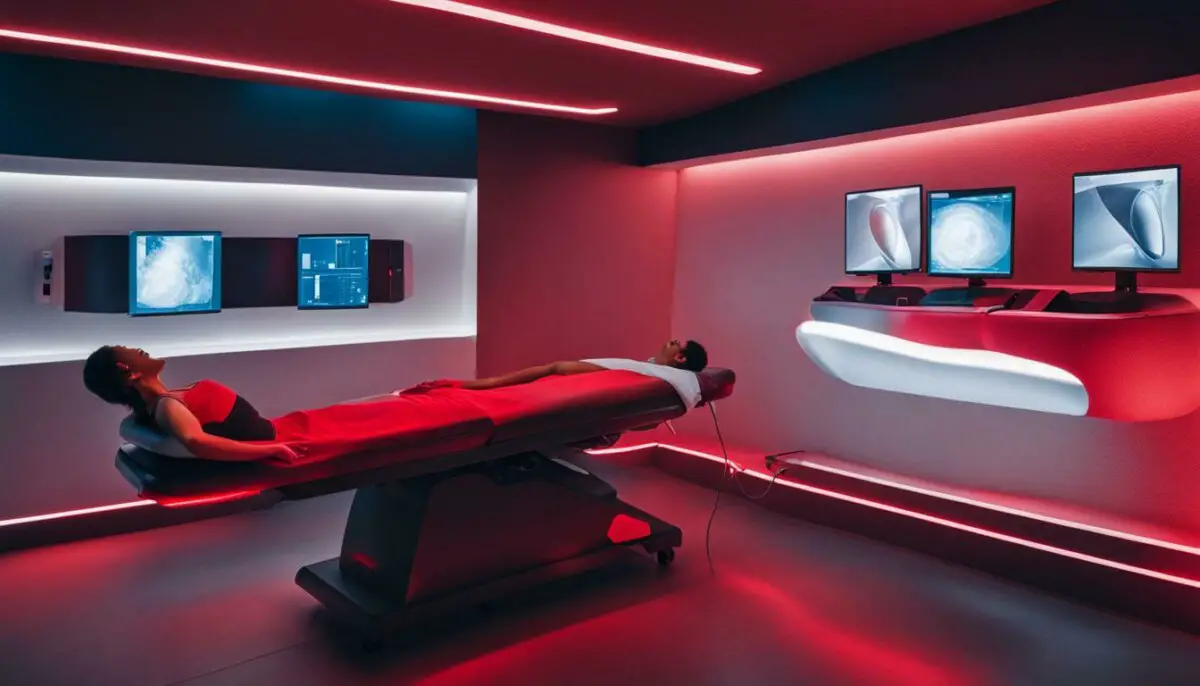Last Updated on 6 months by Francis
As science and technology continue to advance, we are introduced to new and innovative ways to treat various health conditions. Two popular therapies that have gained significant attention are red light therapy and ultrasound therapy. While both treatments have their unique benefits, it’s essential to understand how they differ to determine which option is best suited for your needs.
In this article, we will delve into the benefits of red light therapy and ultrasound therapy and compare their effectiveness for different health concerns. Whether you’re looking to improve your skin health, reduce pain, or accelerate wound healing, we’ve got you covered!
Contents
Key Takeaways:
- Red light therapy and ultrasound therapy are two popular treatments used to target various health concerns.
- Understanding the unique benefits and limitations of each option is crucial in determining which therapy is best suited for your specific health needs.
- Factors such as the condition you’re targeting, convenience, and personal preferences should be considered when choosing the right therapy option.
- While both therapies offer significant benefits, it’s essential to consult with a healthcare professional to determine the most suitable treatment plan for your individual needs.
- Alternative therapies may complement or provide additional benefits to red light therapy and ultrasound therapy.
Benefits of Red Light Therapy
Red light therapy, also known as low-level laser therapy, is a non-invasive treatment that uses red light wavelengths to penetrate the skin and promote healing. This therapy has numerous benefits for the body and mind, including:
- Promoting skin health: Red light therapy has been found to stimulate collagen production and reduce inflammation, making it an effective treatment for skin conditions such as acne, rosacea, and psoriasis. It has also been found to reduce the appearance of fine lines and wrinkles, giving the skin a youthful glow.
- Relieving pain: Red light therapy can alleviate pain caused by conditions such as arthritis, fibromyalgia, and back pain. It works by reducing inflammation and increasing blood flow to the affected area, promoting healing and reducing discomfort.
- Enhancing muscle recovery: Athletes and fitness enthusiasts often use red light therapy to improve muscle recovery time after exercise. By reducing muscle inflammation and promoting circulation, red light therapy can help muscles heal more quickly and effectively.
| Image of Red Light Therapy in Use |
|---|
 |
“Red light therapy has been found to stimulate collagen production and reduce inflammation, making it an effective treatment for skin conditions such as acne, rosacea, and psoriasis.”
Benefits of Red Light Therapy for Skin Health
As mentioned, red light therapy is an effective treatment for various skin conditions. By stimulating collagen production, red light therapy can help reduce the appearance of fine lines and wrinkles, while also promoting skin elasticity and firmness. Additionally, it can help to reduce inflammation and redness associated with conditions such as acne and rosacea.
The best part? Red light therapy is completely non-invasive, so it’s suitable for all skin types and doesn’t require any recovery time.
If you’re looking to improve your skin health and reduce the appearance of fine lines and wrinkles, red light therapy may be the perfect solution for you.
Benefits of Ultrasound Therapy
Ultrasound therapy is a non-invasive treatment option that has been found to have various benefits for individuals dealing with inflammation and tissue repair. Some of the benefits of ultrasound therapy are:
| Benefits of Ultrasound Therapy | Explanation |
|---|---|
| Pain relief | Ultrasound therapy has been found to effectively reduce pain by stimulating the production of endorphins, the body’s natural painkillers. |
| Inflammation reduction | Ultrasound waves can penetrate deep into tissues, promoting faster healing and reducing inflammation. |
| Tissue repair | Ultrasound therapy can enhance the production of collagen, a key component in tissue repair, and promote improved healing outcomes. |
Ultrasound therapy is commonly used to treat conditions such as tendinitis, bursitis, and arthritis. It has also been found to have therapeutic benefits for individuals dealing with soft tissue injuries and post-surgical recovery.
It’s important to note that ultrasound therapy may not be suitable for individuals with certain medical conditions or during pregnancy. It’s always best to consult with a healthcare professional before starting any new therapy.
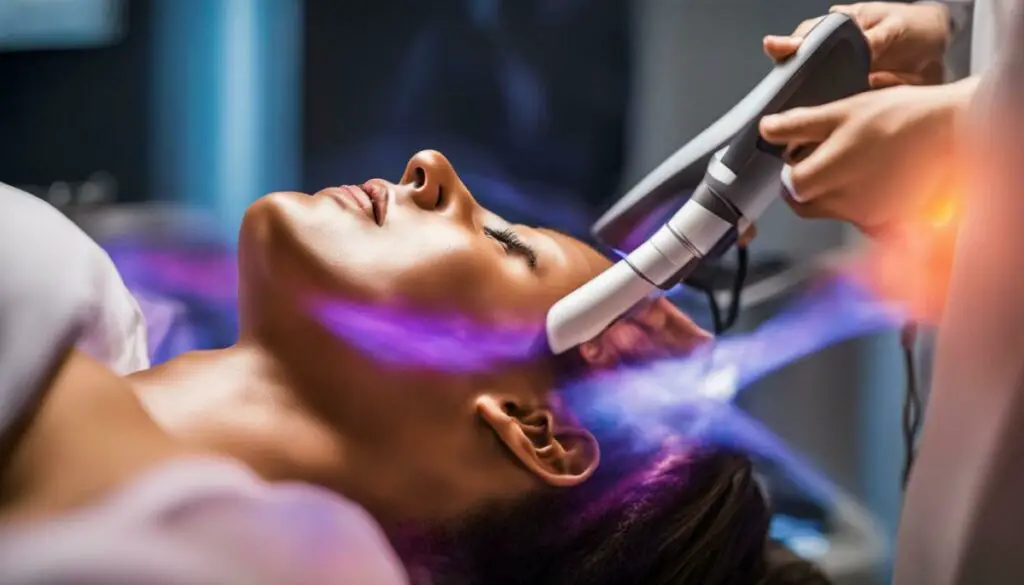
Red Light Therapy for Skin Health
Red light therapy has emerged as a popular treatment option for skin health in recent years. It has been found to offer numerous benefits for the skin, making it an appealing option for individuals looking to improve their skin’s appearance and health.
One of the primary benefits of red light therapy for the skin is its ability to reduce the appearance of fine lines and wrinkles. Studies have shown that red light therapy stimulates collagen production, which helps to plump the skin and reduce the appearance of lines and wrinkles. Additionally, it has been found to improve skin texture and tone.
Red light therapy also offers anti-inflammatory benefits, which can help reduce redness and irritation in the skin. By reducing inflammation, it can also improve conditions such as acne and rosacea.
Another benefit of red light therapy for the skin is its ability to promote wound healing. It has been found to accelerate the healing of wounds and reduce the risk of infection. This makes it a useful option for individuals with cuts, burns, or other skin injuries.
Finally, red light therapy has been found to improve circulation in the skin. By enhancing blood flow, it can help improve overall skin health and promote a more youthful appearance.
Overall, red light therapy is a safe and effective option for individuals looking to improve their skin health. It offers numerous benefits, from reducing the appearance of fine lines and wrinkles to improving wound healing and promoting better circulation.

Red Light Therapy vs Ultrasound for Pain Relief
Pain relief is a common concern for many individuals, and both red light therapy and ultrasound therapy have been found to be effective options. While the mechanisms behind their pain relief benefits are different, both therapies can provide relief from various types of pain.
Red light therapy works by stimulating the production of ATP, which is essential for cellular energy. This, in turn, promotes healing and reduces inflammation in the affected area. It has been found to be effective in providing relief from chronic pain, arthritis, and muscle soreness.
Ultrasound therapy uses high-frequency sound waves to penetrate deep into the tissue, providing a warming sensation that can reduce pain and inflammation. It is commonly used for pain relief in soft tissue injuries, such as tendonitis and sprains.
Both therapies have their unique advantages, and the choice between the two largely depends on the type and severity of the pain. While red light therapy is ideal for chronic pain and muscle soreness, ultrasound therapy is better suited for soft tissue injuries.
It’s important to note that these therapies should not be used as a substitute for proper medical treatment. If you are experiencing severe or persistent pain, it’s essential to consult with a healthcare professional before attempting any form of therapy.

Red Light Therapy for Muscle Recovery
Athletes and fitness enthusiasts are always looking for ways to enhance their performance and speed up recovery time. Red light therapy has gained popularity in recent years as a natural and non-invasive way to promote muscle recovery.
When our muscles are stressed during exercise or physical activity, they can experience microscopic tears and inflammation. This can result in soreness, stiffness, and decreased muscle function. Red light therapy can help to alleviate these symptoms and improve overall muscle recovery.
The red and near-infrared wavelengths of light used in red light therapy penetrate deep into the skin and stimulate the mitochondria in our cells. This leads to increased production of ATP, which is the primary source of energy for our cells. As a result, our cells can function more efficiently, leading to faster healing and recovery.
Red light therapy can also help to reduce inflammation in the muscles. Inflammation is a natural response to tissue damage, but if left unchecked, it can impede the healing process. Red light therapy helps to reduce inflammation by promoting the release of cytokines and other anti-inflammatory molecules.
Studies have shown that red light therapy can improve muscle strength, function, and endurance. It can also reduce muscle damage and soreness after intense exercise. Overall, red light therapy is a safe and effective way to promote muscle recovery and enhance athletic performance.

Ultrasound Therapy for Inflammation
Inflammation is a common symptom for various conditions, including arthritis and sports injuries. Ultrasound therapy can help alleviate inflammation and provide relief for those suffering from inflammatory conditions.
Ultrasound waves penetrate deep tissue and increase blood flow to the affected area, stimulating the healing process. The increased blood flow carries oxygen and nutrients to the injured tissue, promoting cell repair and reducing inflammation.
| Benefits of Ultrasound Therapy for Inflammation |
|---|
| Reduces pain and swelling: Ultrasound therapy works by reducing inflammation, which in turn reduces pain and swelling in the affected area. |
| Non-invasive: Unlike some other treatments for inflammation, ultrasound therapy is non-invasive and does not require medication or injections. |
| Speeds up recovery time: By promoting cell repair and reducing inflammation, ultrasound therapy can help speed up recovery time for injuries and conditions that cause inflammation. |
It’s important to note that ultrasound therapy is not suitable for everyone. Individuals with certain conditions, such as pacemakers or cancer, may not be able to receive ultrasound therapy. As with any medical treatment, it’s essential to consult with a healthcare professional before beginning any new therapy.
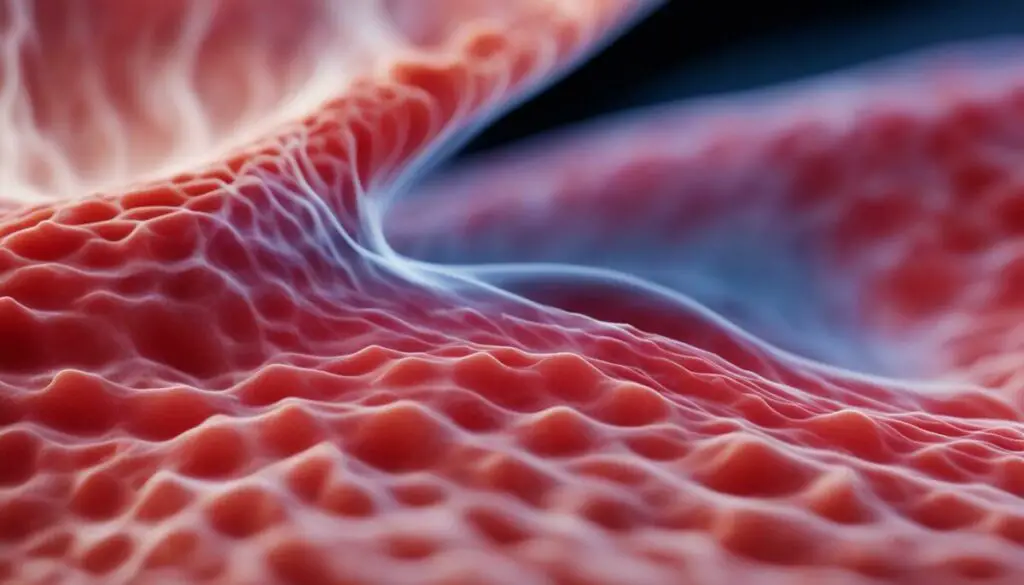
Red Light Therapy for Wound Healing
Wound healing is a complex process that requires proper circulation and cell regeneration. Red light therapy offers numerous benefits for individuals seeking to improve their wound healing outcomes.
Red light therapy increases collagen production, which is essential for skin repair and wound healing. It also stimulates blood flow and oxygenation, which helps to promote cell growth and regeneration.
One study conducted on diabetic patients with foot ulcers found that red light therapy significantly improved wound healing outcomes. Patients who received red light therapy had a faster healing time and higher overall healing rate than those who received conventional treatments alone.
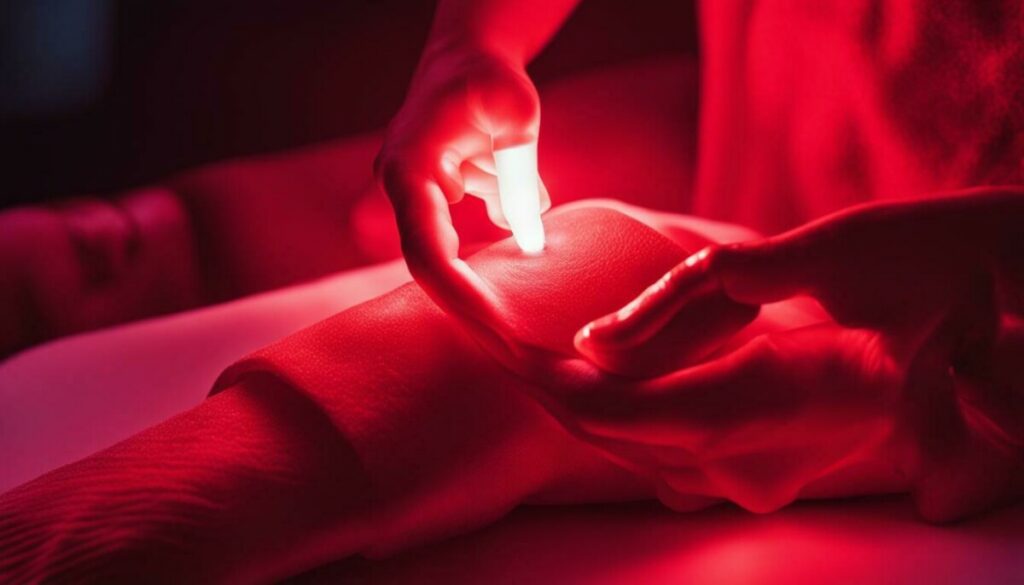
In addition to improving wound healing outcomes, red light therapy can also reduce the risk of infection by promoting the production of white blood cells. This helps to fight off infection and support the body’s natural healing process.
If you are recovering from surgery or have a chronic wound that requires healing, red light therapy may be an effective treatment option for you. Consult with a healthcare professional to determine if red light therapy is suitable for your specific condition.
Ultrasound Therapy for Tissue Repair
When it comes to tissue repair, ultrasound therapy is a popular treatment option. This therapy has been found to promote tissue regeneration, enhance collagen production, and improve overall healing outcomes.
Ultrasound therapy works by utilizing high-frequency sound waves targeted to the affected area. These sound waves penetrate deep into the tissue, promoting blood flow and reducing inflammation. This process helps to accelerate the healing process and enhance tissue repair.
One of the key benefits of ultrasound therapy for tissue repair is its ability to stimulate collagen production. Collagen is a crucial component of the body’s connective tissue and plays a vital role in wound healing. By promoting collagen production, ultrasound therapy can improve the strength and flexibility of new tissue, reducing the risk of reinjury.
| Benefits of Ultrasound Therapy for Tissue Repair |
|---|
| • Promotes tissue regeneration |
| • Enhances collagen production |
| • Improves overall healing outcomes |
Ultrasound therapy has been found to be effective in treating a variety of conditions that involve tissue damage or inflammation. These include:
- Injuries such as sprains, strains, and tears
- Osteoarthritis
- Tendinitis
- Bursitis
- Plantar fasciitis
Ultrasound therapy is generally considered safe and has few side effects. However, it is important to note that certain individuals may not be suitable candidates for this therapy. This includes pregnant women, people with pacemakers, and those with certain types of cancer.

If you are considering ultrasound therapy for tissue repair, it is important to consult with a healthcare provider to determine if this treatment option is right for you.
Comparing Red Light Therapy and Ultrasound Therapy
Now that we have explored the benefits of red light therapy and ultrasound therapy separately, it’s time to compare them head-to-head. Understanding the differences and similarities between these two treatments can help you make an informed decision about which therapy is right for you.
Effectiveness: Both red light therapy and ultrasound therapy have been found to be effective in promoting pain relief and accelerating healing. Red light therapy is particularly effective for skin health, while ultrasound therapy is known for its ability to reduce inflammation.
| Red Light Therapy | Ultrasound Therapy | |
|---|---|---|
| Pain Relief | Can provide pain relief for various conditions, such as arthritis and muscle pain. | Can effectively reduce inflammation, which can lead to pain relief. |
| Skin Health | Can reduce the appearance of fine lines and wrinkles, promote collagen production, and reduce inflammation in the skin. | Not typically used for skin health. |
| Muscle Recovery | Can enhance muscle healing, reduce inflammation, and improve overall recovery time. | Can help with promoting tissue repair and reducing inflammation, which can lead to better muscle recovery. |
Application: Red light therapy and ultrasound therapy are applied in different ways. Red light therapy involves exposing the skin to red light for a specific amount of time, while ultrasound therapy uses high-frequency sound waves to penetrate deep into the tissues.
Side Effects: Both therapies have minimal side effects, although some individuals may experience minor skin irritation with red light therapy. Ultrasound therapy may cause slight discomfort during treatment.
Overall, choosing between red light therapy and ultrasound therapy will depend on your specific health needs and preferences. If you’re looking to improve skin health or enhance muscle recovery, red light therapy may be the way to go. If you’re dealing with inflammation or tissue repair, ultrasound therapy may be the better option. Consult with a healthcare professional to determine which therapy is right for you.
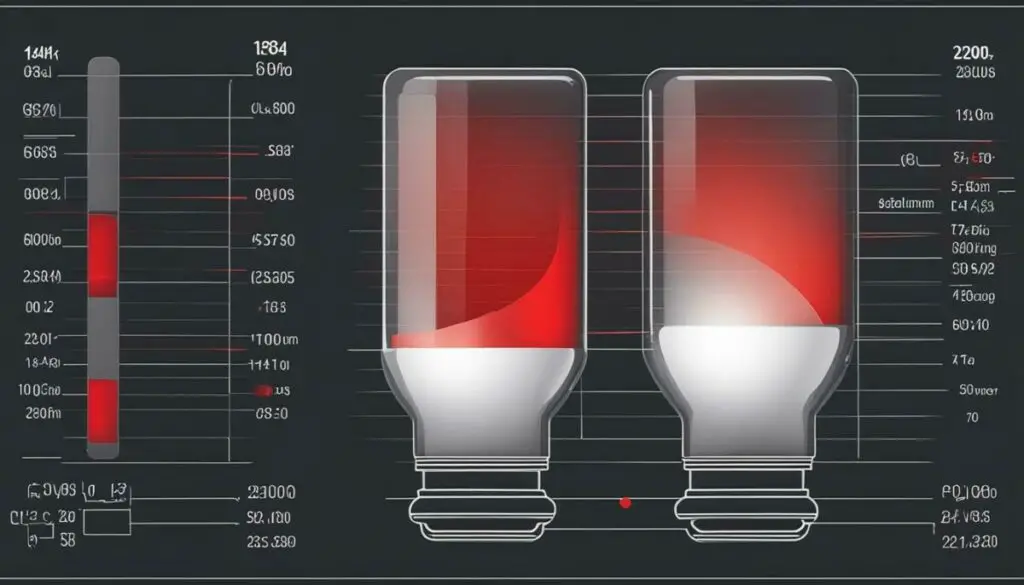
Choosing the Right Therapy for You
After exploring the benefits of red light therapy and ultrasound therapy, you may be wondering which option to choose. When deciding, consider the following factors:
Condition Being Treated
The first thing to consider is the condition you’re targeting. While both red light therapy and ultrasound therapy provide pain relief, they work differently and target different types of pain. Red light therapy is better suited for surface-level pains and skin concerns, while ultrasound therapy is better suited for deep tissue pain and inflammation.
Convenience
Another factor to consider is convenience. Red light therapy can be done at home with a handheld device, while ultrasound therapy requires a visit to a healthcare professional’s office. If you have a busy schedule or prefer at-home treatments, red light therapy may be a better choice for you.
Personal Preferences
Your personal preferences also come into play when choosing the right therapy option for you. Some people may prefer the soothing warmth of red light therapy, while others may prefer the pressure and vibration of ultrasound therapy.
Ultimately, the best option for you depends on your specific health needs and personal preferences. It’s always a good idea to consult with a healthcare professional before starting any new treatment.

Understanding the Limitations
While red light therapy and ultrasound therapy offer significant benefits for various health concerns, it’s essential to understand their limitations to ensure you make an informed decision before incorporating them into your healthcare routine.
Red light therapy is generally considered safe and non-invasive; however, it may not be suitable for individuals with photosensitivity or those taking certain medications that increase sensitivity to light. It is also important to note that red light therapy may not be effective for all types of skin conditions or injuries, and more severe conditions may require additional medical treatment.
Ultrasound therapy is also considered safe and non-invasive, but it may not be suitable for individuals with implanted medical devices or current infections in the treatment area. It is also important to note that ultrasound therapy should not be used over areas with broken skin or tumors as it may stimulate tumor growth.
It’s crucial to consult with a healthcare professional before incorporating red light therapy or ultrasound therapy into your healthcare routine. They will evaluate your specific health needs and determine if the treatment is the right fit for you.
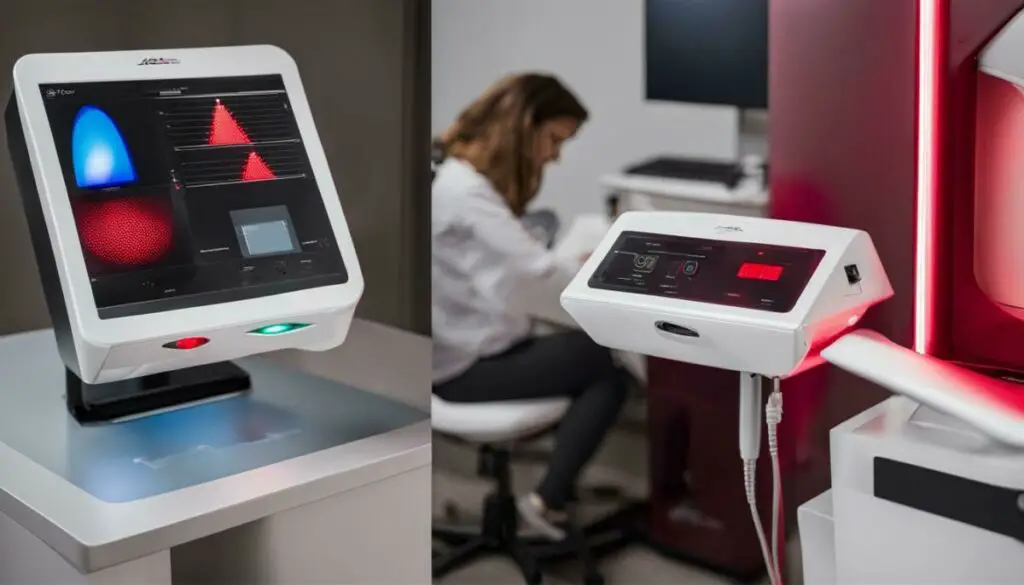
Understanding the Limitations: A Personal Experience
“I initially turned to red light therapy for my severe acne, and I was thrilled with the results. However, after a few weeks of consistent treatment, I noticed my skin becoming increasingly sensitive to the light. I realized that I should have consulted with a healthcare professional before beginning the treatment, as it was ultimately not suitable for my specific needs. It’s essential to understand the limitations of these therapies before beginning any treatment.”
Exploring Other Therapeutic Options
While red light therapy and ultrasound therapy have proven to be effective for various health concerns, there are other therapeutic options worth considering. These options can complement or provide additional benefits to the discussed therapies.
Massage therapy: Massage therapy is a popular option for pain relief, relaxation, and muscle recovery. It can improve blood flow, reduce soreness, and promote overall well-being.
Acupuncture: Acupuncture is a traditional Chinese practice that involves inserting thin needles into specific points on the body. It can help with pain, stress, and various health conditions.
Chiropractic care: Chiropractic care involves the manipulation of the spine and joints to alleviate pain and improve function. It can also help with headaches, neck pain, and other health concerns.
Cryotherapy: Cryotherapy involves exposing the body to extremely low temperatures to reduce inflammation, decrease pain, and promote healing. It can also improve athletic performance and aid in weight loss.
Hydrotherapy: Hydrotherapy involves using water to relieve pain, promote relaxation, and improve overall health. It can include activities such as hot tubs, saunas, and aquatic exercises.
It’s important to consult with a healthcare professional before trying any new therapeutic option. They can provide guidance on the most suitable treatment for your specific health needs.

Conclusion
Red light therapy and ultrasound therapy both offer unique benefits for various health concerns. While red light therapy is more suitable for skin health, pain relief, and muscle recovery, ultrasound therapy is more effective for tissue repair and inflammation reduction. Choosing between the two depends on your specific health needs, preferences, and the advice of a healthcare professional.
It’s important to note that both therapies have limitations and potential side effects, and may not be suitable for certain individuals. It’s essential to understand these limitations and consult with a healthcare professional before starting any therapy.
If neither red light therapy nor ultrasound therapy seems like the right fit for you, there are various other therapeutic options available. These may complement or provide additional benefits to the discussed therapies. Some examples include physical therapy, massage therapy, and acupuncture.
Make an Informed Decision
By understanding the benefits and limitations of red light therapy and ultrasound therapy, you can make an informed decision about which treatment option is best suited for your health needs. Consider factors such as the condition you’re targeting, convenience, and personal preferences, and always consult with a healthcare professional before starting any therapy.
Thank you for reading this article on red light therapy vs ultrasound therapy. We hope you found it informative and helpful in making the right choice for your health.
FAQ
What is red light therapy?
Red light therapy, also known as photobiomodulation, is a non-invasive treatment that uses low-level red light wavelengths to promote healing, reduce pain, and improve various health conditions.
What is ultrasound therapy?
Ultrasound therapy involves using high-frequency sound waves to treat various musculoskeletal conditions. It can stimulate tissue repair, reduce inflammation, and provide pain relief.
What are the benefits of red light therapy?
Red light therapy has been found to improve skin health, promote pain relief, and aid in muscle recovery.
What are the benefits of ultrasound therapy?
Ultrasound therapy is known for its therapeutic effects on inflammation and tissue repair.
How does red light therapy benefit the skin?
Red light therapy can improve skin health by reducing the appearance of fine lines and wrinkles, promoting collagen production, and reducing inflammation.
How does red light therapy compare to ultrasound therapy for pain relief?
Both red light therapy and ultrasound therapy have been effective in providing pain relief, but they work through different mechanisms. Red light therapy targets pain receptors, while ultrasound therapy increases blood flow and promotes tissue healing.
How can red light therapy aid in muscle recovery?
Red light therapy can enhance muscle healing, reduce inflammation, and improve overall recovery time for athletes and fitness enthusiasts.
How does ultrasound therapy reduce inflammation?
Ultrasound therapy can effectively reduce inflammation by increasing blood flow, promoting tissue relaxation, and reducing edema.
How does red light therapy accelerate wound healing?
Red light therapy accelerates wound healing by stimulating cell regeneration, improving circulation, and reducing inflammation.
How can ultrasound therapy promote tissue repair?
Ultrasound therapy promotes tissue repair by enhancing collagen production, increasing blood flow, and stimulating cell activity.
What are the similarities and differences between red light therapy and ultrasound therapy?
While both therapies offer unique benefits, red light therapy primarily targets skin health and pain relief, while ultrasound therapy focuses on inflammation and tissue repair. The choice between the two depends on the specific condition and desired outcome.
How can I choose the right therapy option?
When choosing between red light therapy and ultrasound therapy, consider factors such as the condition you’re targeting, convenience, and personal preferences. It’s best to consult with a healthcare professional for guidance.
Are there any limitations or side effects of these therapies?
While red light therapy and ultrasound therapy are generally safe, there may be some limitations and potential side effects. It’s important to understand any contraindications and consult with a healthcare professional before starting these treatments.
Are there other therapeutic options worth exploring?
In addition to red light therapy and ultrasound therapy, there are alternative treatments available such as laser therapy, electromagnetic therapy, and heat therapy. These may complement or provide additional benefits to the discussed therapies.

